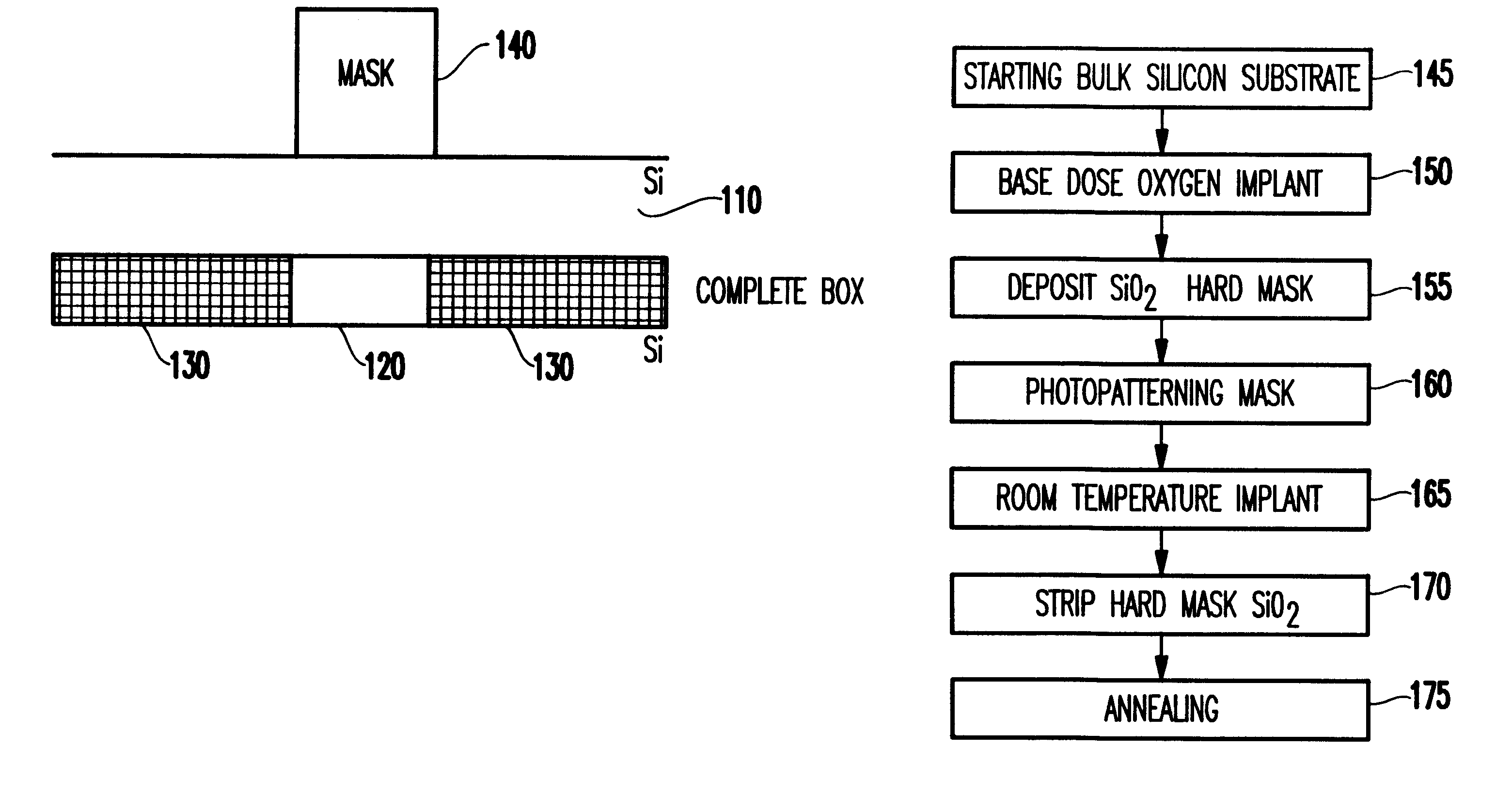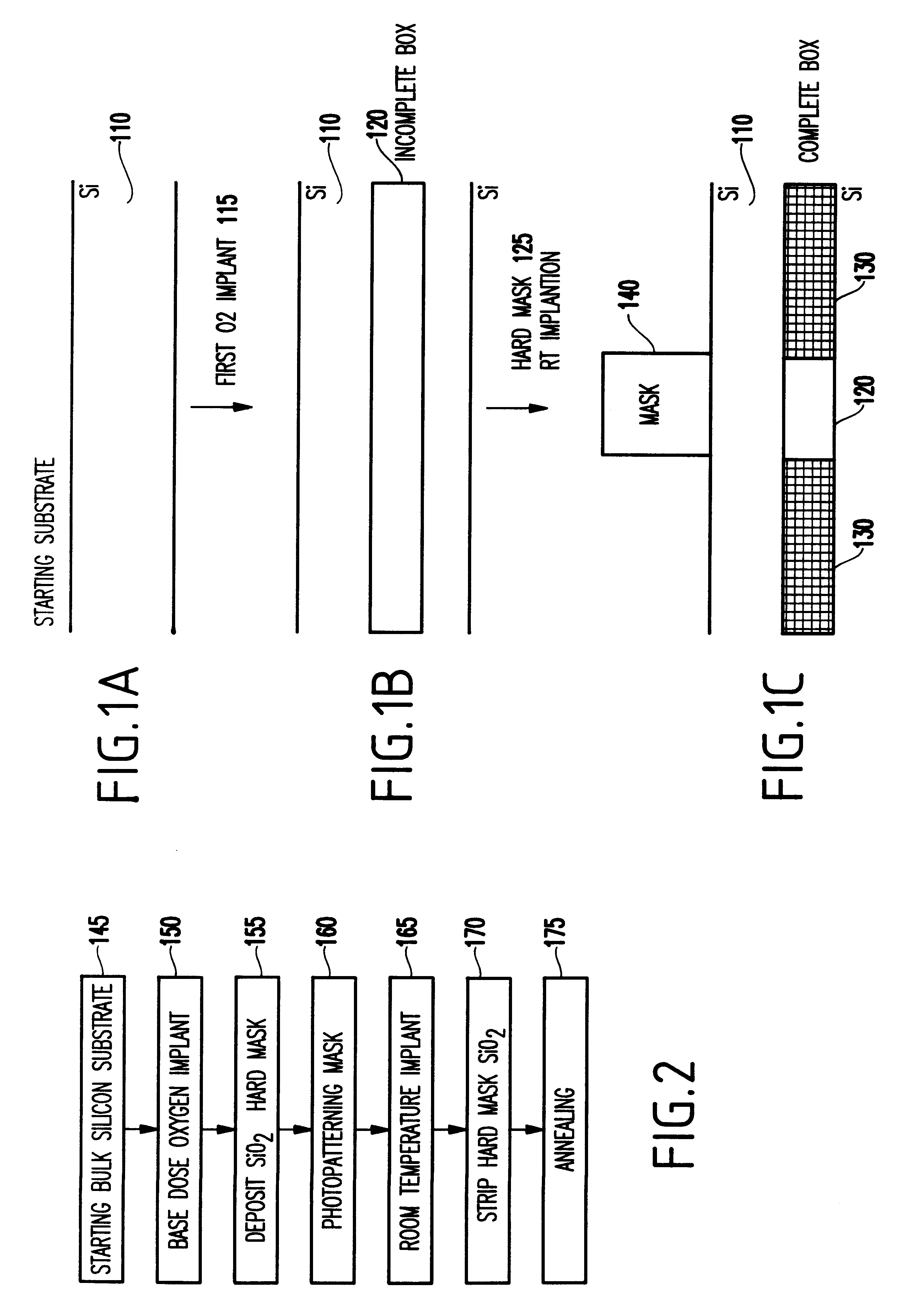Method of forming a body contact using BOX modification
a technology of body contact and box modification, which is applied in the direction of basic electric elements, semiconductor/solid-state device manufacturing, electric devices, etc., can solve the problems of increasing the size of the device, and affecting the operation of the devi
- Summary
- Abstract
- Description
- Claims
- Application Information
AI Technical Summary
Problems solved by technology
Method used
Image
Examples
second embodiment
FIGS. 3A, 3B, 3C and FIG. 4 illustrate the present invention, which is an alternative desirable way to produce a body contact with a controllable BOX leakage by slightly adjusting the RT implant conditions until the desired leakage levels are achieved.
FIGS. 3A, 3B, and 3C show the structure of the second embodiment, more specifically a silicon substrate 210 undergoing a first oxygen implant and a room temperature implant 215 forming a complete BOX 230 in the silicon substrate layer 210 followed by a hard mask 240 and room temperature implantation 225. The complete structure is shown with the mask 240 on top of the silicon substrate layer 210 with a plurality of leaky BOX regions 220 shown sandwiching a complete BOX region 230.
The table below (Table 1) shows the dependence the BOX leakage has when the RT implant energy or dose is varied around the operating conditions typically used to produce a low leakage BOX. Table 1 shows that an increase in energy results in an ever-increasing B...
first embodiment
This second alternative sequence produces a body contact through a leaky BOX material only in the areas defined by the photopatterning of the hard mask. Because only slight modifications are made to the RT implant, any morphology problems inherent with the first embodiment are minimized. The amount of BOX oxidation during annealing is the same everywhere in this embodiment since it is exposed to both the base and the RT implant. The third ion implant is then used to create leakage with a minimal effect on topography.
FIGS. 5A, 5B, 5C and FIG. 6 illustrate a third embodiment of the present invention, which is an alternative method used to achieve the desirable results described in embodiment 2, without performing the RT implant twice. Here, a thin hard mask is used such that it only partially blocks the RT implant. The hard mask thickness and RT implant conditions are optimized to achieve the effect shown in Table 1, which once again shows how the BOX leakage increases as the RT impla...
third embodiment
FIGS. 5A, 5B, and 5C show the structure of the third embodiment, more specifically a silicon substrate 310 undergoing a first oxygen implant 315 forming an incomplete BOX 320 in the silicon substrate layer 310 followed by a thin hard mask pattern 341, and room temperature implantation 325. The complete structure is shown with a plurality of mask regions 341, on top of the silicon substrate layer 310 with a plurality of complete BOX regions 330 shown sandwiching an incomplete BOX region 320.
The sequence to achieve these results is detailed in FIG. 6, which shows the process of first starting 345 with a bulk silicon substrate 310, and then adding 350 a base dose oxygen implant 315 with predetermined parameters (dose 3.3E 17, energy 210 KeV, temperature 350.degree. C.). Then, a SiO.sub.2 hard mask 341 is deposited 355 using conventional masking techniques, at a thickness sufficient to block a subsequent room temperature implant from entering the silicon substrate. The thickness is "tun...
PUM
 Login to View More
Login to View More Abstract
Description
Claims
Application Information
 Login to View More
Login to View More - R&D
- Intellectual Property
- Life Sciences
- Materials
- Tech Scout
- Unparalleled Data Quality
- Higher Quality Content
- 60% Fewer Hallucinations
Browse by: Latest US Patents, China's latest patents, Technical Efficacy Thesaurus, Application Domain, Technology Topic, Popular Technical Reports.
© 2025 PatSnap. All rights reserved.Legal|Privacy policy|Modern Slavery Act Transparency Statement|Sitemap|About US| Contact US: help@patsnap.com



